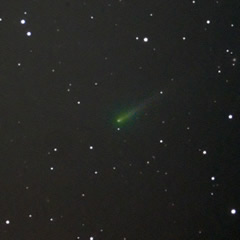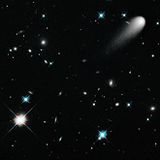
Comet ISON has brightened and is now in the constellation Virgo in the predawn sky. As of November 9, from a dark sky location, Comet ISON is bright enough to see with any telescope that Orion offers, shining around magnitude 8.0. So grab your gear and see the comet! Some tips for comet viewers are below:

Comet ISON, imaged on 10.06.13 by Doug Hubbell.
Take a telescope. While comet ISON has brightened a lot, it is still needs a telescope the week of November 11 to see it. By the end of the week, it should be visible in large binoculars.
Use low power. You don't need a high power to see the comet. A low power eyepiece (with a larger number or focal length, say 18mm or larger) gives a wide field of view and a brighter image, perfect for comet ISON.
Get away from city lights. We can't emphasize enough that the comet is best seen from a dark sky location (one where you can see the milky way). City lights and moonlight vastly overpower most stars, galaxies ands comets.
Rise early. The comet is rapidly moving towards the sun in the morning sky, so you need to get out pre dawn to catch it now. The best viewing will be this week, about 4 a.m., and before 5:15 a.m. as the sky will brighten so much after about 5:15 that the comet is overpowered by the pre-dawn sky.
Know where to look. The comet is still relatively small and dim, so you can't walk outside, look up and see it - though it may get that bright later this year. Check out Orion's Comet ISON page in the Community section of telescope.com for maps and charts of its location, and any new updates. Resources such as Starry Night software will help you get an up-to-date star chart, but remember, the comet is moving pretty fast against the background stars and its position changes slightly every day.




















